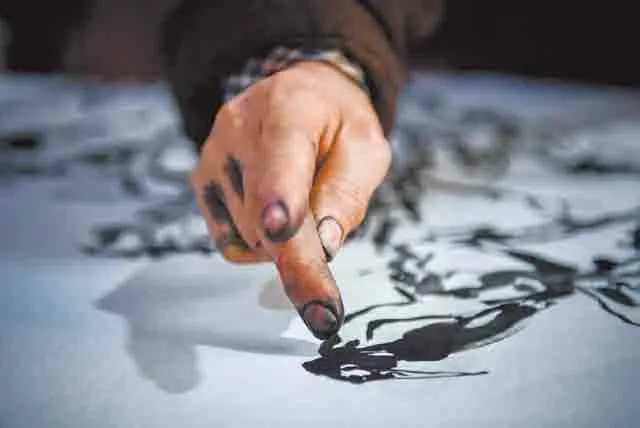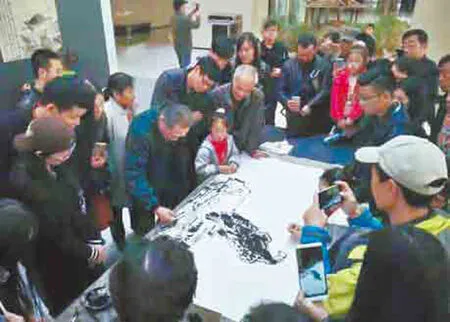Supple Strokes Spawn Sublimity
2021-07-06TextbyHuangZhongPhotosbyLiuZhongcan
Text by Huang Zhong Photos by Liu Zhongcan
The strokes say it all.Yu Xiaofeng dips his fingers into an inkwell and lets them roam nimbly on the page,twirling like a dragon in flight swirling through the clouds.His lithe touch flits flirtatiously over the papyrus-like paper,and in a matter of moments,a speedy sketch with assumedly arbitrary patterns juxtaposed helter-shelter forms into the perfect likeness of Wintersweet shrubs.As it gets close to its completion,branches and twigs,plums,and magpies of jaw-dropping realism jump right off the page.
Finger painting,also known by other monikers such as finger drawing and finger inking,is a singular painting style with a longstanding tradition that uses fingers dipped in ink to paint in lieu of a brush.According to records,finger drawing began in the Tang Dynasty,and today there is only a handful of individuals practicing the art,Pan Tianshou,Quan Songyan,and Yu Yifeng are among its leading exponents.

Yu Xiaofeng’s Artwork 虞小风作品
提手演示,只见虞小风掌指蘸墨,掌走游龙、指点勾勒,不到几分钟,一幅指画腊梅图几近完成,枝桠、红梅、喜鹊栩栩如生,跃然纸上。
指画,又称指头画、手指画、指墨画等,是中国传统绘画中的一种特殊画法,以手代笔,蘸墨作画。据载,指画起于唐代,如今从事指画的已不多,潘天寿、钱松喦、虞一风等是指画的代表。
1949年出生的虞小风师承其父——著名指画大师虞一风衣钵,8 岁开始学画,潜心指画创作和研究数十载,最终自成一体。“十年画鹰,十年画荷,十年画山水。”在位于武汉市江夏庙山的虞一风指画馆内,只见他画的雄鹰搏击长空、浑厚古朴、大气磅礴;他画的秋荷,挂着莲蓬,傲立苍穹,出淤不染;他画的山水则风骨暗藏、韵味悠长。“鹰代表着入世的拼搏精神,荷代表着出世的淡泊情怀,山水则现文人的中庸之道。”虞小风说。
在虞小风看来,指画与笔画相比,用指头、指尖、指背甚至掌纹作画,其线条与笔画有明显不同。其最大的特点是“甲肉半间”,即指画蘸墨画时会产生“双勾”效果,指甲和肉之间的空处会留白,指头点染则会产生半实半虚的罗纹,“虚实之间格外有韵味和美感”。“我总结手指画的魅力在于:残缺古拙的金刚之味,力透纸背的阳刚之气,直抒胸臆的率真之美。”虞小风说。
祖籍浙江宁波的虞小风,2000年客居江夏,创建“江夏画派中国画研究院”。为什么将基地选在江夏?虞小风说,江夏是中国指画发源地,明代山水人物画家吴伟就是江夏人,是吴伟创建了“江夏画派”。
作为中国手指画研究会会长,以及当代为数不多的有影响力的指画传人,72 岁的虞小风除潜心创作外,一直在为挽救这门濒临失传的中国传统艺术而奔走。多年来,他自驾在全国100 余个城市传播指画,行程达20 万公里。
Born in 1949,Yu Xiaofeng studied under the tutelage of his father,renowned finger-painting master Yu Yifeng,from whom he picked up the torch of the craft of finger inking.At the age of eight he began learning art,in which he was wholly absorbed.He has been researching the subject for decades before finally developing his own mature style.“For a decade I painted eagles; for a decade I painted lotuses; for a decade I painted landscapes.” At his gallery located in Miaoshan in Wuhan’s Jiangxia District,one can feast their eyes on the majesty of his creations,such as a bald eagle hunting in mid air—simple and honest,yet striking and dynamic.His painting of winter lotus depicts a lotus seedpod drooping,the stem standing tall and proud to the heavens,rooted in unadulterated silt.His personal style subtly subdued behind the lines and between the lines,yet the image exudes a punchy pluck that whispers its witchery across the soft stillness.“The eagle symbolizes the struggles we face as we make our way in the world; the lotus symbolizes withdrawing from the rat race in favor of a simple existence; the landscape embodies the philosophy of moderation espoused by the modern educated elite,” expressed Yu Xiaofeng.

Enjoying clay teapots in his spare time 闲暇时喜欢玩紫砂壶
In Yu Xiaofeng’s eyes,finger painting and brush painting stand in contrast,finger drawing uses the fingers,the fingertips,the backs of the fingers,and even the palms to make art.The lines and strokes are distinctly different.Its greatest distinguishing feature is a rendering technique that involves“part finger,part fingernail,”producing a “hollow stroke” effect.The area between the finger and fingernail is empty and leaves a white space,the fingertips ink a pattern that is part full,part empty,which makes the piece all the more“aesthetically appealing.” Xiaofeng asserted,“I can only say the appeal of finger painting is in its powerful sense of crude fragmentation that gives is a penetrating energy,and a candid and unreserved radiance.”
Since 2000,Yu Xiaofeng,a native of Ningbo,Zhejiang Province,has been living in Jiangxia,Wuhan where he founded the Jiangxia Chinese Painting Research Institute.Why did he choose Jiangxia as his base of operations? Yu Xiaofeng remarked that Jiangxia was the birthplace of Chinese finger painting,and Wu Wei,a Ming Dynasty landscape painter and founder of the Jiangxia Finger Painting Academy,was a native of Jiangxia.
As the president of the Chinese Finger Painting Research Association and one of the few influential heirs of finger painting in the modern era,the 72-year-old Yu Xiaofeng has been working hard to save this traditional Chinese art that is on the verge of being lost forever.Over the years,he has driven to more than 100 cities across the country to promote finger painting,traveling a total distance of 200,000 kilometers in a concerted effort and labor of love to pass the torch of finger painting onto a new generation who live and breathe the art.
(Translation:Chase Coulson)

Finger painting 手指作画

Demonstrating finger drawing at the Hubei Museum of Art在湖北美术馆展示指画

Taking care of his yard 打理自家庭院
